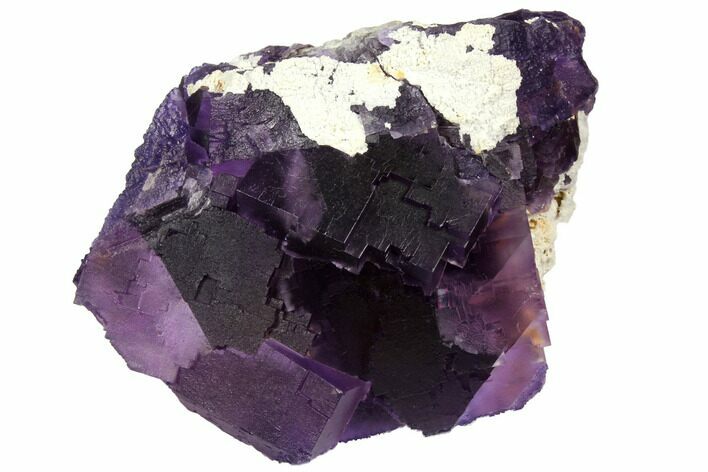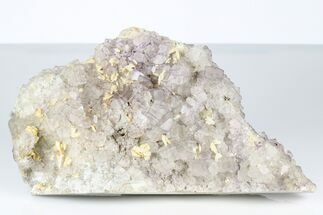This Specimen has been sold.
6.8" Purple, Cubic Fluorite Cluster - Cave-In-Rock, Illinois
This is a beautiful cluster of purple stepped-cubic fluorite crystals from the Cave-In-Rock district of Harden County, Illinois. The crystals are in excellent condition and feature a stepped formation. The purple fluorite sits atop a mixture of yellow fluorite and white bladed barite. The base of this fluorite is relatively flat, allowing for aesthetic presentation of the crystals without the need for a display stand.
About Cave-In-Rock Fluorite
The Cave-In-Rock mining district of Hardin County, Illinois is world renowned for its fluorite, which is widely considered to be some of the highest quality fluorite in the world. The area has a long history of producing spectacular fluorite specimens from several different mines. All of the major mines have been closed for years and the cutoff in supply has sent prices of this material soaring. A recently bored mine is now producing small amounts of material, but hasn't made a dent in demand or prices.
Archaeological discoveries near the Cave-In-Rock mining district found beads and other ornaments made of fluorite, placing use of the stone in the area to about 900 years ago, when the land was inhabited by the Native Mississippian Americans. Early European settlers mining for galena in the 1830s discarded fluorite they mined, since the lead they sought was more valuable at the time. Fluorite found new use in the 1880s in a new steel-furnace technology and demand increased considerably, leading to the emergence of several commercial fluorite mining companies in the Illinois/Kentucky region.
Fluorite is a halide mineral comprised of calcium and fluorine with the chemicla formula CaF2. The word "fluorite" is from the Latin fluo, which means to flow. In 1852 fluorite gave its name to the phenomenon known as fluorescence, or the property of fluorite to glow a different color depending upon the bandwidth of the ultraviolet light it is exposed to.
Fluorite occurs commonly in cubic, octahedral and dodecahedral crystals in many different colors. These colors range from colorless and completely transparent to yellow, green, blue, purple, pink or black. It is most commonly found in purple and/or green.
The Cave-In-Rock mining district of Hardin County, Illinois is world renowned for its fluorite, which is widely considered to be some of the highest quality fluorite in the world. The area has a long history of producing spectacular fluorite specimens from several different mines. All of the major mines have been closed for years and the cutoff in supply has sent prices of this material soaring. A recently bored mine is now producing small amounts of material, but hasn't made a dent in demand or prices.
Archaeological discoveries near the Cave-In-Rock mining district found beads and other ornaments made of fluorite, placing use of the stone in the area to about 900 years ago, when the land was inhabited by the Native Mississippian Americans. Early European settlers mining for galena in the 1830s discarded fluorite they mined, since the lead they sought was more valuable at the time. Fluorite found new use in the 1880s in a new steel-furnace technology and demand increased considerably, leading to the emergence of several commercial fluorite mining companies in the Illinois/Kentucky region.
Fluorite is a halide mineral comprised of calcium and fluorine with the chemicla formula CaF2. The word "fluorite" is from the Latin fluo, which means to flow. In 1852 fluorite gave its name to the phenomenon known as fluorescence, or the property of fluorite to glow a different color depending upon the bandwidth of the ultraviolet light it is exposed to.
Fluorite occurs commonly in cubic, octahedral and dodecahedral crystals in many different colors. These colors range from colorless and completely transparent to yellow, green, blue, purple, pink or black. It is most commonly found in purple and/or green.
About Barite (Baryte)
Barite is a barium sulfate mineral (BaSO₄) known for its high specific gravity, which makes it unusually heavy for a non-metallic mineral. Typically forming in tabular or bladed crystals, barite can also appear in massive, fibrous, or nodular habits. Its colors range from colorless and white to shades of blue, yellow, gray, or brown, often influenced by trace impurities. Barite commonly forms in hydrothermal veins, sedimentary rocks, and as a gangue mineral in lead-zinc ore deposits. It is widely used in industrial applications, especially as a weighting agent in drilling muds for oil and gas exploration. Its striking crystal formations and vivid hues also make it a popular mineral for collectors.
Barite is a barium sulfate mineral (BaSO₄) known for its high specific gravity, which makes it unusually heavy for a non-metallic mineral. Typically forming in tabular or bladed crystals, barite can also appear in massive, fibrous, or nodular habits. Its colors range from colorless and white to shades of blue, yellow, gray, or brown, often influenced by trace impurities. Barite commonly forms in hydrothermal veins, sedimentary rocks, and as a gangue mineral in lead-zinc ore deposits. It is widely used in industrial applications, especially as a weighting agent in drilling muds for oil and gas exploration. Its striking crystal formations and vivid hues also make it a popular mineral for collectors.
SPECIES
Fluorite & Barite
LOCATION
Cave-In-Rock, Harden County, Illinois
SIZE
6.8 x 4.5 x 4.3"
CATEGORY
SUB CATEGORY
ITEM
#128361
 Reviews
Reviews















